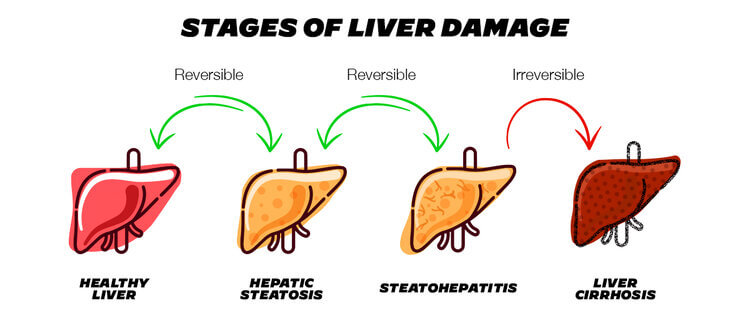The liver is the second largest organ in our body. It also performs varied functions. Primarily, it serves a protective function, acting as a sieve in filtering toxic elements from the bloodstream. It further aids in digestion by extracting nutrients from the food and drinks we consume. Particularly, the liver makes proteins and stores iron for us. We also rely on our livers to aid digestion by making bile. (1)
The liver also regulates glucose by storing and releasing it. This enables our periods of fasting. (2) Glucose is metabolised by the liver in 2 ways. In a fed state, the liver sources dietary fat from the intestine as triglycerides, an efficient storage form. While fasting, the adipose tissue, which stores fatty acids as triglycerides, supplies them to the liver to fuel our muscles. The flow of this fatty acid is regulated by the liver, as it transforms and distributes energy. During fatty liver disease, this process is incomplete, and the processed triglycerides do not fuel muscles, instead spiking glucose levels in our blood. (3)
What is fatty liver disease?
Fatty liver disease has an accurate name. It signifies a state of excess fat building up in one’s liver. Past a certain point, fat in the liver can contribute to its inflammation. Inflammation is the body’s method of fighting against factors that damage it, like infections, injuries, and toxins, in an attempt to heal itself. This condition can prevent the smooth functioning of a liver and can escalate to scarring. In some cases, fatty liver can lead to liver damage and liver failure. Fatty Liver disease doesn’t usually exhibit symptoms but some of them are (6):
- An ache in the abdomen (upper right of the belly)
- Loss of appetite or weight
- Nausea
- Edema
- Jaundice
- Physical weakness and tiredness or mental confusion
Fatty liver can be of two types: non-alcoholic fatty liver disease (NAFLD) or alcoholic fatty liver disease (AFLD). This bifurcation is based on the amount of alcohol consumed by the person diagnosed.
Causes of FLD & its relationship with alcohol
At a metabolic level, fatty liver disease occurs when the body has an excess of fat. This could be a result of producing too much fat, or even from the inefficient metabolization of fat. Here’s how fat metabolism works. In case of fatty liver disease, there is an impairment in this process.
Fats or lipids are broken down in the liver for use as energy. They are then transferred to fat tissue. Over 90% of body energy is stored here and is the primary source of fuel storage for the body. Adipose tissue holds fat from any increased weight, which is routinely transferred to the liver. Fats are insoluble in blood and water and so the liver manufactures special, fat-carrying proteins called lipoproteins. These lipoproteins circulate in the blood, carrying essential fatty acids between the liver and body tissues.
Triglyceride molecules represent the major form of storage and transport of fatty acids within cells and in the plasma. Fatty acids are eradicated by oxidation within the cell or by secretion into the plasma within triglyceride-rich, low density lipoproteins.
The liver has 2 sources that cause fatty acid accumulation: adipose tissue and volatile glucose fluctuations. Unusual levels of glucose fluctuation alter fat metabolism, leading to excess fat produced passing onto the liver for storage.
Excess alcohol consumption can be a cause for fatty liver disease, and is considered to be the beginning of alcohol related diseases. The liver’s protective function takes apart alcohol in the body to remove it. A large share of alcohol we drink is altered by our liver using an enzyme called alcohol dehydrogenase (ADH). ADH takes alcohol to acetaldehyde. Another enzyme, aldehyde dehydrogenase (ALDH) alters the acetaldehyde form into acetate. Acetate eventually leaves the body as carbon dioxide and water.
The remainder is broken down by another group of enzymes, usually when blood alcohol levels are high. Frequent consumption of large amounts of alcohol increases the use of this set of enzymes. (7) As a side effect, this also causes fatty acids to be made and stored by the liver. Since it is caused by the habit of excess alcohol consumption, such fatty liver disease is labelled AFLD.

NAFLD and its causes
In a study published in the journal, Metabolic Syndrome and Related Disorders, metabolic health is described as having ideal levels of blood sugar, triglycerides, high-density lipoprotein (HDL) cholesterol, blood pressure, and waist circumference, without using medications.
People with fatty liver disease often have a condition called insulin resistance. The cells in their body make insulin but can’t use it well and are resistant to its influence. Glucose tends to build up in your blood, and your liver turns it into fat.
When triglycerides accumulate in the liver, it can lead to increased gluconeogenesis, decreased glycogen synthesis, and inhibition of insulin signalling.
High-density lipoprotein (HDL), a cardiovascular disease protective marker, is found to decrease in patients with fatty liver disease.
Studies suggest that accumulation of belly fat may symbolise an important underlying mechanism for the correlation between liver enzymes and hypertension.
Non-alcoholic fatty liver disease (NAFLD) has more layered causal elements. Currently, research studies indicate that high levels of blood pressure and cholesterol are factors, as are obesity and type 2 diabetes. Type 2 diabetes is also a potential effect of fatty liver disease, as those with the condition carry livers producing more glucose.
How to prevent AFLD & NAFLD
To protect oneself from fatty liver (whether AFLD or NAFLD) and its further complications, it is essential to follow a healthy lifestyle. Here are its elements:
- Limit or avoid alcohol to prevent AFLD. Talk to your doctor about what amount of alcohol is right for you.
- Maintain your weight within a healthy range and eat a diet packed with nutrients and low on saturated and trans fats as well as refined carbohydrates.
- Monitor your levels – blood sugar, triglyceride, and cholesterol and follow all medical advice to keep them in check.
- Exercise for 30 minutes on most days of the week. Exercise affects fatty liver disease through various pathways. Enhanced peripheral insulin resistance reduces the excess delivery of free fatty acids and glucose for free fatty acid synthesis to the liver. In the liver, exercise increases fatty acid oxidation, decreases fatty acid synthesis, and prevents mitochondrial and hepatocellular damage through a reduction of the release of damage-associated molecular patterns. Physical exercise is a proven therapeutic strategy to improve fatty liver disease. Consistent exercise helps to burn triglycerides for fuel and can also reduce liver fat.
Living with NAFLD and AFLD
It is possible to live a sparsely altered life with either NAFLD or AFLD. However, it is important to know that fatty liver disease has 4 levels:
Healthy liver – Liver blood tests can assess liver functions. The most extensively used liver enzymes are aminotransferases. The normal range of values for AST (SGOT) is about 5 to 40 units per litre of serum (the liquid part of the blood). The normal range of values for ALT (SGPT) is about 7 to 56 units per litre of serum.
Hepatic steatosis – Deposition of fat in the liver is termed steatosis.
Steatohepatitis- It is a kind of fatty liver disease, characterized by inflammation of the liver with concurrent fat accumulation in the liver.
Liver cirrhosis – In the late-stage liver disease of Cirrhosis healthy liver tissue is substituted with scar tissue and the liver is permanently damaged.
One can reverse the damage on one’s liver until steatohepatitis. Primarily, this can be achieved through lifestyle changes and consulting with one’s doctor. However, liver cirrhosis, the clinical term for a scarred liver, is irreversible. It also puts the person at risk for liver cancer and failure, both of which are terminal.
Conclusion
The state of one’s liver is a mirror and measure of metabolic health. It prevents and protects the body from toxic elements as well as makes the most of the nutrients we consume. To keep the liver in good health and prevent it from deteriorating into Fatty Liver Disease, it is vital to optimise metabolic health, limit alcohol intake, exercise consistently and maintain weight in a healthy range with an optimal diet.
References
- Fatty Liver Disease: Risk Factors, Symptoms, Types & Prevention (clevelandclinic.org)
- https://www.ncbi.nlm.nih.gov/pmc/articles/PMC5293555/
- Triglyceride metabolism in the liver (nih.gov)
- The liver and metabolism | Hepatitis C Trust (hepctrust.org.uk)
- https://www.britannica.com/science/sympathetic-nervous-system







